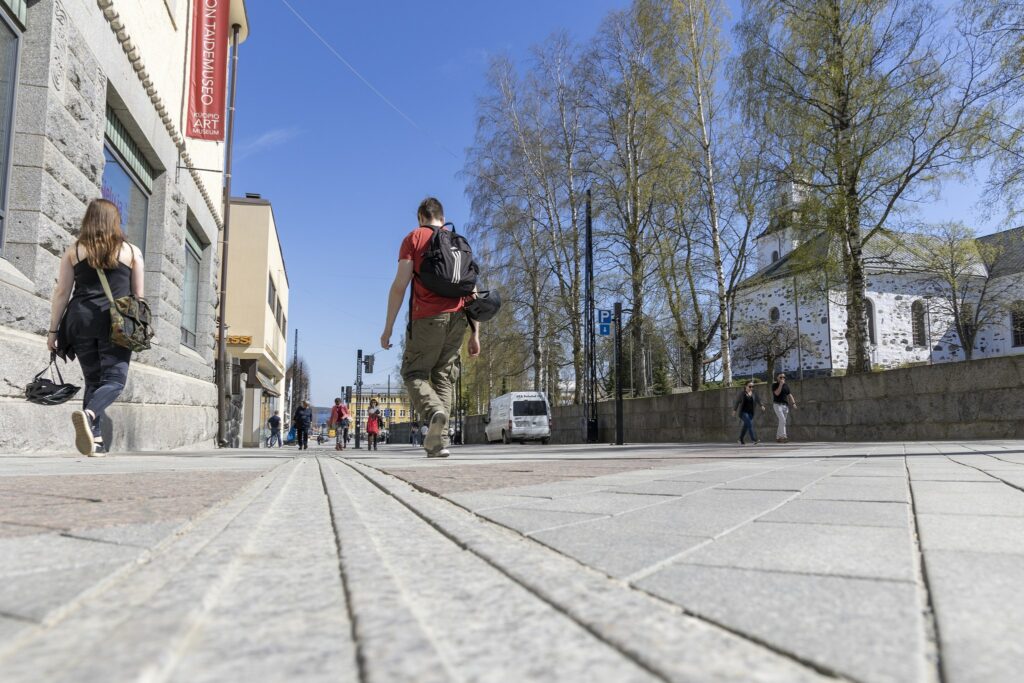General accessibility plan

The City of Kuopio has received a state grant for the promotion of road safety activities from Traficom for the project “Accessibility as a cornerstone in the promotion of traffic safety in Kuopio” (Esteettömyys kivijalkana Kuopion liikenneturvallisuuden edistämisessä). The project time was between February 2023 and December 2023. The objective of the project is to promote the traffic safety of walking environments by improving their accessibility and to increase the knowledge of the city organisation and the citizens about accessible and traffic-safe solutions.
What does accessibility mean in an outdoor environment?
In an accessible outdoor environment:
• An accessible and safe route is visible in the walking environment.
• Accessible travel chain to, for example, public service locations.
• Accessible green and recreational areas.
• People can move around the city without getting lost, colliding, falling, tripping or slipping.
Examples:
• Pedestrian crossings are clear and safe.
• Bus stops are placed to be easily accessible and marked clearly.
• Traffic signs, lights, guide boards and address signs can be easily distinguished from their backgrounds.
• Traffic is controlled and changes in the passageway are warned about by visible and tangible guiding, warning and distinguishing markings on the ground, as well as by beeping traffic lights, for example.
General plan
Urban Structure Board of the City of Kuopio has approved general plan for accessibility on its meeting on 28th of February 2024. Read more about the general plan (pdf, in Finnish). See the whole material of the Urban Structure board meeting (in Finnish).
Quality routes
Explored areas were city center, Puijonlaakso, Männistö, Levänen, Petonen and rural communities (Juankoski, Karttula, Maaninka, Nilsiä, Riistavesi and Vehmersalmi). The focus was on environments where older people or people with reduced mobility and functional capacity move more than usual. Plots and properties are excluded from the project.
Based on expert assessments and an extensive interaction process, the service and leisure destinations were identified, that should be reached without barriers, and uniform travel chains were formed between these destinations and public transport stops.
The routes were named as pedestrian quality routes, in total 50,4 kilometers. In the city center and its surrounding areas, pedestrian quality routes are indicated on two different levels, divided according to the functionality.
Some of the routes are functionally focused on business and commuting traffic, and on some of the routes movement is focused either on free time or recreation or the routes does not have any specific functionality.
The classification of pedestrian quality routes into functional categories has been made to support the determination of the quality criteria of the routes and the urgency of the measures.
You can find out more about pedestrian quality routes by looking maps below. Routes are marked by the area and by different colours: red is pedestrian quality route, blue is business and commuting route and turquoise is a route to be implemented in the future.
- To the city center and its surroundings in total 25,2 km (additionally defined guide board routes)
- Levänen, 3 km
- Petonen and Pirtti, 4,6 km
- Juankoski, 3,2 km
- Karttula, 3 km
- Maaninka, 1,9 km
- Nilsiä, 4,8 km
- Riistavesi, 2,4 km
- Vehmersalmi, 1,7 km
New quality routes are explored in co-operation with city planning and, for example, neighborhood reforms.
Definition of criteria
Criteria were defined for example:
- for separating pedestrian and cycling lanes
- for placing benches
- on crosswalks to curb heights and the gradient of asphalt ramps
- to the flatness and longitudinal gradient of the fairways/passageways
- for improving the marking of pedestrian crossings
- to improve the accessibility of traffic light push buttons
- for the construction of warning areas
- for lightning
Read more about the criteria (pdf, in Finnish)
Accessibility surveys and actions
Based on the surveys and criteria, action maps and tables were formed for pedestrian quality routes. Quality route measures are planned annually, and they are implemented within the budget. Some of the measures are linked to the measures of the traffic safety plan 2030 and will progress with that plan.